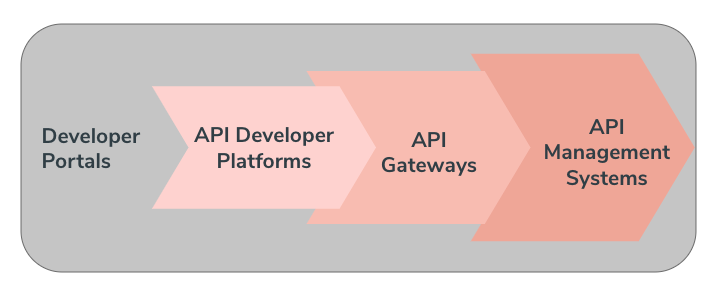We often receive questions about API management tools. Do I need to use an API gateway? Is the documentation portal provided by my API developer platform enough for my needs? Why should I use an API management system and which one will meet my needs? Do I have to have an API gateway to have a developer portal? My API Gateway gives me a developer portal, how many of these things do I need?
For the purpose of this article, we will define the API developer platform, API gateway, API management system, and the developer portal. There is sometimes considerable overlap between two or three of these depending on the provider. The question of whether to collect your API documentation in the ‘portal’ provided by your developer platform, gateway interface, or your management system leads to a choice overload. For this reason, although we provide examples later in the article, we will refrain from comparing branded solutions.
Developer Portal
API developer platforms, API gateways, and API management platforms will all have some form of documentation portal for onboarding or documentation of APIs. However, not all of these documentation structures are built equally and with a wide end-goal in mind. As a category to itself, the developer portal is strongly linked with the documentation and developer experience of consuming the APIs and in some cases producing/collaborating to produce the APIs.
Most developer portals have ready integration to gateway management solutions as needed. For example Zero Gravity developer portals integrate with Apigee Edge natively.
Examples of independent or gateway agnostic developer portals include: Pronovix’ Zero Gravity developer portals, Constellant, RapidAPI, Readme.io, Redoc.ly.
API Developer Platforms
API developer platforms focus on collaboration, automated testing, design, documentation, workspace, and API monitoring.
- API-first development considers the upstream developer journey that is prior to deploying coded solutions.
- API developer platforms enable front-end and back-end development to happen simultaneously.
- These platforms automate manual tests and usually have a CI/CD pipeline.
- Keeping in line with the developer journey, they readily integrate with Git providers.
- These platforms provide a documentation focused portal to accommodate the need to onboard consumer developers and provide relevant API documentation.
Examples of API developer platforms include: Postman, Swagger, Apiary, and Stoplight.
API Gateways
Focus on connectivity, security, and access.
- API gateways act as a separate layer that allows API upstream production to meet with downstream API consumption.
- API gateways provide provisioning keys, licensing, wrapping (e.g. Apigee allows you to wrap ugly high-functional backend APIs in a beautiful way on the frontend to benefit the end users experience), load balancing for high volume API use cases, and caching.
- With API gateways, subscription data is obtained at a basic level.
Examples of API gateways include: Google Cloud Endpoints, Amazon AWS, and SAP API Gateway where Spring Cloud Gateway, KrakenD, API Umbrella, TreeGateway, Yap, and Ambassador Edge Stack are open source.
API Management Systems
Many API gateways have an extended API management system which focuses on detailed API analytics, reporting on performance, uptime/availability/ and calls made to single or bundled APIs, monetization, and additional documentation.
Examples of API management systems include: Google Apigee, MuleSoft, Microsoft Azure, Axway Amplify, IBM API Connect, Dell Boomi, CA Broadcom, Perforce Akana, Senisedia, and Oracle Cloud Infrastructure (OCI) where Kong, WSO2, Tyk, RedHat, Gravitee.io, and Moesif (Analytics only) are open source.
There are a lot of options for API developer platforms, gateways, and management systems with fierce competition driving product evolution and creating much overlap. Most mature open source solutions are further complicated by the requirement to upgrade or subscribe to more flexible, feature-rich enterprise solutions. In some cases, the solution requires additional third party open source plugins (for example to create a dashboard or to implement a Service Mesh to work as a proxy).

Conclusion
API programs are born and driven by a desire to innovate. Just because you create an interface does not mean that you have immediate knowledge of how that interface will be used or whether your business will see this as a marketing tool, a product in itself, or a part of a solution.
If you are a developer shop looking to develop APIs and to document as you go, you may find the API developer platform is just the right fit for your needs. In contrast, if you have determined that your APIs require key management and user management an API gateway may be up your alley. Finally, if monetization and business alignment are what you need - then look into an API management system.
Most programs have a clear goal in mind when they start.
As the API program itself matures, at some point you will graduate where you are and enroll in the next level.
In all cases whether you have big or small plans, even if you’re a startup, you can begin with a developer portal and add the gateway integration when you need it.
IF you have big plans, even if you’re a startup - begin with a developer portal.

Developer Portal Maturity Model The developer portal maturity model uses three axis: operational maturity, developer experience, and business alignment to determine where you want to be or where you need to be based on your business and needs.
Why should I use an API management system and which one will meet my needs?
There is no simple answer here. In our next blog post in this series we will talk about key factors that you can take into consideration to help make your decision. In particular, we look at the contrasting needs of the API Consumer to those of the upstream developer journey.
References
- 2020 Forrester Report
- DZone: API Management vs API Gateway: Where Does API Analytics and Monitoring Fit?
- Dev.to: Open Source API Gateways?
- Software Testing Help: Top 10 Best API Management Tools with Feature Comparison
- Trust Radius: API Management Tools (& Reviews)
- The new stack: 5 Ways to succeed with an API Gateway
- My experiences with API Gateways (Mahesh Mahadevan)
Special thank you to Apigee’s Kevin Bouwmeester and Raymond Peng for their advice and experience that contributed to this blog series. All Pronovix publications are the fruit of a team effort, enabled by the research and collective knowledge of the entire Pronovix team. Our ideas and experiences are greatly shaped by our clients and the communities we participate in.


